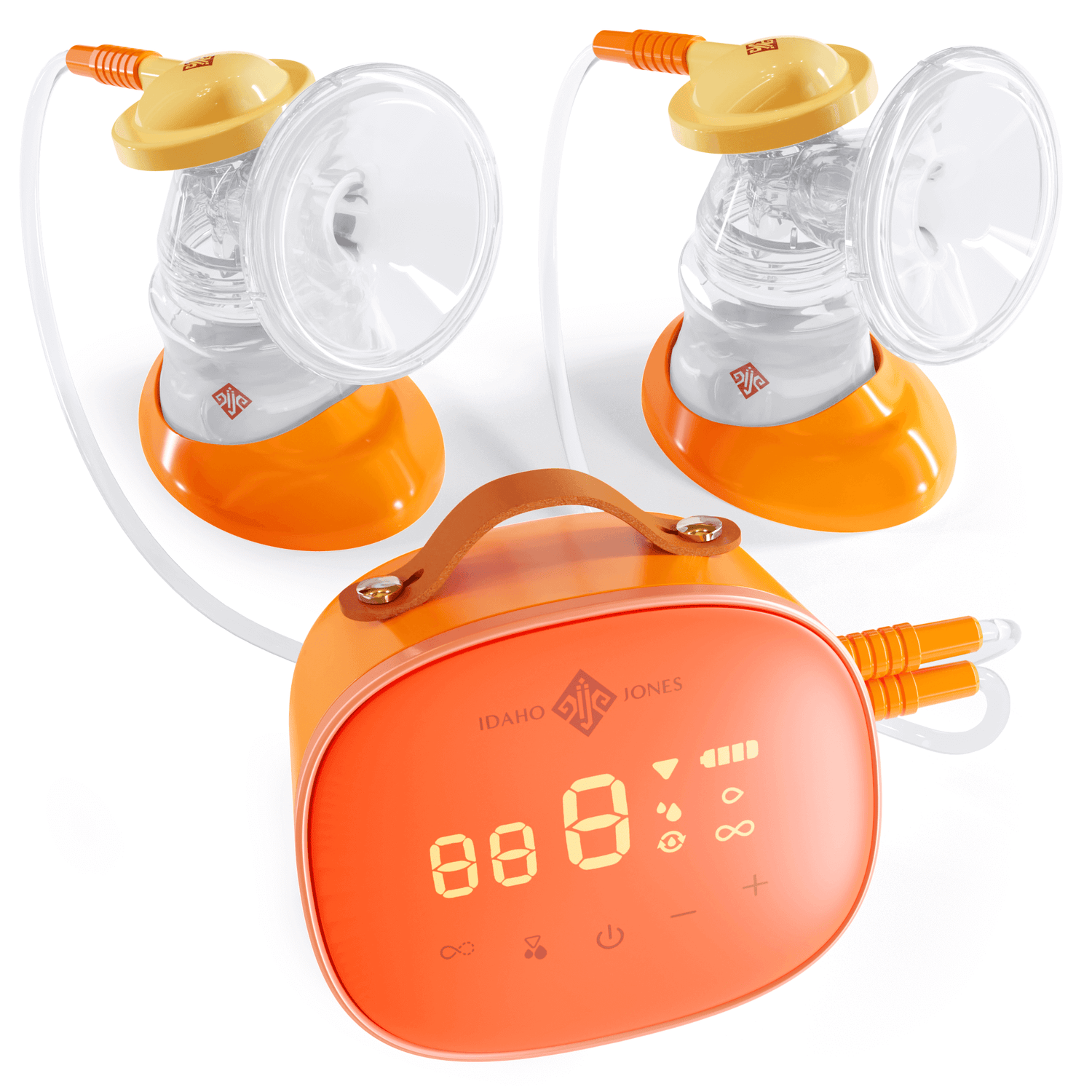
Laid Back Breastfeeding
Share
What is Laid Back Breastfeeding?
Laid back breastfeeding is when the mother semi-reclines comfortably, well-supported by pillows, and the baby is placed “tummy to mummy,” to latch on and breastfeed on top of her. This can be done skin-to-skin or clothed, with clothing pushed out of the way for access to the breast. There is no one “right” way to do laid back breastfeeding. Because the breast and nipple are circular--think of a clock face-- the baby can be placed tummy to mummy in any position on top of the mom like the hands of a clock, to latch on from any angle. This is great for moms with sore nipples, who need to “switch it up” in order to protect a tender spot if the nipple has been cracked or rubbed raw (ouch!) or for moms who’ve had a c-section, to protect the incision area while it heals.
While there is no one right way to do it, it is essential that the mother be comfortable. This is one of the most wonderful aspects of the laid back approach to breastfeeding: mom gets to chill. Start with a comfortably warm room, lots of soft pillows, and all the privacy you need to feel confident and relaxed. You are going to be spending a lot of time feeding your baby in the next days, weeks, and months so why not create a comfy little nest for you and your baby and settle in?
Laid back. But not too laid back.
You won’t want to fully recline. That will make it difficult to meet your newborn’s gaze comfortably. Lying supine (fully reclined on your back) with the baby on top of you also puts a lot of pressure on the vena cava, which will inhibit the flow of blood and oxygen to your heart and make you uncomfortable. Lying supine can also just feel vulnerable and disempowering, which is not what we want for you!
A New Approach: Biological Nurturing and Laid Back Breastfeeding.
Laid back breastfeeding is more than just the latest breastfeeding position. Laid back breastfeeding is a shift from a skills based approach to breastfeeding to an instinctual approach. Putting the baby on their tummy on top of the mom allows the baby’s innate instinctual behaviors to kick in. It seems to allow mom’s instinctual nurturing behaviors and her confidence to flourish, too. Laid back breastfeeding can facilitate effective feeding, bonding, and joy!
On their backs, many of the newborn reflexes and behaviors babies exhibit seem to make no sense and seem to get in the way of breastfeeding, but when placed on their bellies on mom’s tummy these same behaviors help a baby find the breast and nipple and breastfeed. Human babies are no different from other newborn mammals in this respect, they all have an innate drive to seek the nipple and instinctual behaviors that help them get there and feed. In fact, human babies, when placed on their mom’s belly after birth and left undisturbed, have the ability to crawl to the breast and self-latch.
Laid back breastfeeding represents a big shift in our skills-based approach to breastfeeding success. When you place your baby tummy to mummy, think of it like returning your baby to their natural habitat! If you have a baby that seems to fight you at the breast, who thrashes and seems disorganized when it comes to feeding time, try a laid back approach to breastfeeding and see what unfolds. You just may be amazed not only by how your baby calms and settles when they are placed tummy to mummy, but by the innate instinctual feeding behaviors your baby will show you once there.
How do you know if you are doing it right?
Laid back breastfeeding isn’t just about laying back in a semi-reclined position, it’s also about being “laid back” about breastfeeding. That includes not needing external validation from experts. According to British midwife Suzanne Colson, who is credited not only with coining the term “laid back breastfeeding,” but also with being the first researcher to investigate it and bring the concept to the scientific community as well as the public, there’s no one way to do it right. “Mothers and babies are versatile feeders,” she says. “There is not one way to do it right...The right position is the one that works.”
It can be as simple as this, says Dr. Colson:
“If you feel comfortable with no neck or shoulder strain and can remain in this position for 30 minutes to an hour, if you have at least one hand free, if your baby attaches and drinks your milk, then it is likely that you are doing everything right.” Of course, all that being said, some moms will find they feel more confident and prefer more upright postures instead of laid back breastfeeding, and that is fine. But what a relief the laid back approach can be for those moms who struggle to master the basics of the big three: cradle, cross cradle and football holds. (Be sure to check out our other post on breastfeeding positions, 10 Comfortable Ways To Feed Your Baby for more information.) Laid back breastfeeding is meant to empower breastfeeding mothers on their journey, to show them that they can listen to their baby and their body and find their unique way!
Speaking of listening to your baby, it is important to know that crying is a late indicator of hunger. Long before your baby cries to be fed, your baby will show you that they are hungry and ready to feed with subtle behaviors known as feeding cues. It is important to look for these cues and initiate feeds at the earliest signs of hunger. Watch for mouthing movements or fist to mouth movements. Rooting, or moving the head back and forth to the side (as if in search of the breast) is another feeding cue to be on the lookout for. Even just being awake can be considered a feeding cue in the early days and weeks! It is much better to initiate a laid back breastfeeding session (or any breastfeeding session in any position) when the baby is in the early stages of hunger rather than when the baby is crying, stressed, and disorganized. Trying to feed a crying baby can be stressful and disorganizing for the mom as well and a confidence buster, not a confidence booster.
A Recipe For Success
In laid back breastfeeding, the baby is on top of the mother in such a way that every part of the baby’s body is connected to or supported by the mother’s body, or a pillow, if necessary, for lower legs and feet, but no part of the baby dangles or is left unsupported. In this position mother and baby connect physically and intimately which facilitates and maintains what Colson calls the “hormonal complexion” of new motherhood and breastfeeding. In laid back breastfeeding, feeds are not timed or determined by the clock. Instead, mothers hold their babies for as long and as often as they want—even when the baby is not hungry or feeding. The idea is that in this position, the baby is returned to their natural habitat, the place they are adapted to be in, the place where their innate instinctual behaviors make sense and elicit the desired response from the mother. From the mother’s side, this is where she can get to know her baby powerfully and intimately. From her comfortable, supported, semi-reclined position, the mom can gaze at her baby, groom her baby, stroke her baby, and coo at her baby. The flow of oxytocin, the love hormone, that this intimacy creates within the mother is intensely pleasurable and further facilitates breastfeeding by stimulating milk production and let down.
Many new moms report experiencing feelings of stress or inadequacy or even failure when trying to initiate breastfeeding. What if these feelings weren’t from breastfeeding itself, but rather were from trying to apply rigid and prescriptive instructions to something that can be much more fluid, personal, and intuitive? What if the problem lay in the instructions and advice, and not in the breastfeeding relationship itself? This is what Colson’s research suggests may be the issue.
The remedy? Dr. Colson has a recipe for laid back breastfeeding success. We hope that you will give it a try and let us know how it goes.


